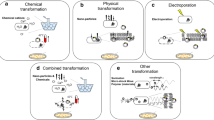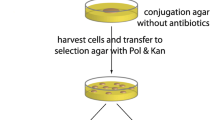Abstract
The protocol presented in this chapter describes a generic method for electrotransformation of Bifidobacterium spp., outlining a technique that is ideal for conferring selective properties onto strains as well as allowing the user to introduce or knock out/in selected genes for phenotypic characterization purposes. We have generalized on the plasmid chosen for transformation and antibiotic selection marker, but the protocol is versatile in this respect and we are able to achieve transformation efficiencies up to 107 transformants/μg of DNA.
Access this chapter
Tax calculation will be finalised at checkout
Purchases are for personal use only
Similar content being viewed by others
References
Sugar IP, Neumann E (1984) Stochastic model for electric field-induced membrane pores electroporation. Biophys Chem 19:211–225
Wong TK, Neumann E (1982) Electric field mediated gene transfer. Biochem Biophys Res Commun 107:584–587
Miller JF, Dower WJ, Tompkins LS (1988) High-voltage electroporation of bacteria: genetic transformation of campylobacter jejuni with plasmid DNA. Proc Natl Acad Sci U S A 85:856–860
Zaharoff DA, Henshaw JW, Mossop B et al (2008) Mechanistic analysis of electroporation-induced cellular uptake of macromolecules. Exp Biol Med (Maywood) 233:94–105
O'Callaghan A, Bottacini F, O'Connell Motherway M et al (2015) Pangenome analysis of Bifidobacterium longum and site-directed mutagenesis through by-pass of restriction-modification systems. BMC Genomics 16:832
Ruiz L, Motherway MO, Lanigan N et al (2013) Transposon mutagenesis in Bifidobacterium breve: construction and characterization of a Tn5 transposon mutant library for Bifidobacterium breve UCC2003. PLoS One 8:e64699
Cronin M, Morrissey D, Rajendran S et al (2010) Orally administered bifidobacteria as vehicles for delivery of agents to systemic tumors. Mol Ther 18:1397–1407
Bernini LJ, Simão AN, Alfieri DF et al (2016) Beneficial effects of Bifidobacterium lactis on lipid profile and cytokines in patients with metabolic syndrome: a randomized trial. Effects of probiotics on metabolic syndrome. Nutrition 32:716–719
O'Callaghan A, van Sinderen D (2016) Bifidobacteria and their role as members of the human gut microbiota. Front Microbiol 7:925–925
Bottacini F, Morrissey R, Roberts RJ et al (2018) Comparative genome and methylome analysis reveals restriction/modification system diversity in the gut commensal Bifidobacterium breve. Nucleic Acids Res 46:1860–1877
Fischer W, Bauer W, Feigel M (1987) Analysis of the lipoteichoic-acid-like macroamphiphile from Bifidobacterium bifidum subspecies pennsylvanicum by one- and two-dimensional 1H- and 13C-NMR spectroscopy. Eur J Biochem 165:647–652
Brancaccio VF, Zhurina DS, Riedel CU (2013) Tough nuts to crack: site-directed mutagenesis of bifidobacteria remains a challenge. Bioengineered 4:197–202
Foroni E, Turroni F, Guglielmetti S et al (2012) An efficient and reproducible method for transformation of genetically recalcitrant bifidobacteria. FEMS Microbiol Lett 333:146–152
Rossi M, Brigidi P, Matteuzzi D (1997) An efficient transformation system for Bifidobacterium spp. Lett Appl Microbiol 24:33–36
Park MJ, Park MS, Ji GE (2018) Improvement of electroporation-mediated transformation efficiency for a Bifidobacterium strain to a reproducibly high level. J Microbiol Methods 159:112–119
O'Connell Motherway M, O'Driscoll J, Fitzgerald GF et al (2009) Overcoming the restriction barrier to plasmid transformation and targeted mutagenesis in Bifidobacterium breve UCC2003. Microb Biotechnol 2:321–332
Law J, Buist G, Haandrikman A et al (1995) A system to generate chromosomal mutations in Lactococcus lactis which allows fast analysis of targeted genes. J Bacteriol 177:7011–7018
Yasui K, Kano Y, Tanaka K et al (2009) Improvement of bacterial transformation efficiency using plasmid artificial modification. Nucleic Acids Res 37:e3
Zhang G, Wang W, Deng A et al (2012) A mimicking-of-DNA-methylation-patterns pipeline for overcoming the restriction barrier of bacteria. PLoS Genet 8:e1002987
Dower WJ, Miller JF, Ragsdale CW (1988) High efficiency transformation of E. coli by high voltage electroporation. Nucleic Acids Res 16:6127–6145
Putman M, van Veen HW, Poolman B et al (1999) Restrictive use of detergents in the functional reconstitution of the secondary multidrug transporter LmrP. Biochemistry 38:1002–1008
Kuipers OP, de Ruyter PGGA, Kleerebezem M et al (1998) Quorum sensing-controlled gene expression in lactic acid bacteria. J Biotechnol 64:15–21
McGrath S, Fitzgerald GF, van Sinderen D (2001) Improvement and optimization of two engineered phage resistance mechanisms in Lactococcus lactis. Appl Environ Microbiol 67:608–616
Cronin M, Knobel M, O'Connell-Motherway M et al (2007) Molecular dissection of a bifidobacterial replicon. Appl Environ Microbiol 73:7858–7866
Alvarez-Martin P, O'Connell-Motherway M, van Sinderen D et al (2007) Functional analysis of the pBC1 replicon from Bifidobacterium catenulatum L48. Appl Microbiol Biotechnol 76:1395–1402
Acknowledgments
This work was sponsored by Nutricia Research, Utrecht, The Netherlands. E.C.H., F.B., J.M., and D.v.S. are members of APC Microbiome Ireland, which is funded by Science Foundation Ireland (SFI) through the Irish Government’s National Development Plan (Grant Numbers SFI/12/RC/2273-P1 and SFI/12/RC/2273-P2).
Author information
Authors and Affiliations
Corresponding author
Editor information
Editors and Affiliations
Rights and permissions
Copyright information
© 2021 Springer Science+Business Media, LLC, part of Springer Nature
About this protocol
Cite this protocol
Hoedt, E.C., Bongers, R.S., Bottacini, F., Knol, J., MacSharry, J., van Sinderen, D. (2021). Bifidobacterium Transformation. In: van Sinderen, D., Ventura, M. (eds) Bifidobacteria. Methods in Molecular Biology, vol 2278. Humana, New York, NY. https://doi.org/10.1007/978-1-0716-1274-3_2
Download citation
DOI: https://doi.org/10.1007/978-1-0716-1274-3_2
Published:
Publisher Name: Humana, New York, NY
Print ISBN: 978-1-0716-1273-6
Online ISBN: 978-1-0716-1274-3
eBook Packages: Springer Protocols




